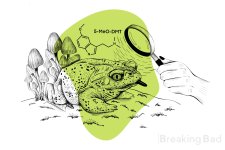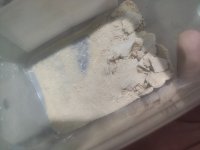WillD
Expert
- Joined
- Jul 19, 2021
- Messages
- 774
- Reaction score
- 1,060
- Points
- 93
Introduction
The synthesis of 5-MeO-Tryptamine from melatonin is a process of considerable interest within the field of organic chemistry and pharmacology. 5-MeO-Tryptamine, a naturally occurring compound found in certain plants and animals, has garnered attention for its potential therapeutic applications, particularly in the treatment of various neurological and psychological disorders. Melatonin, a hormone primarily known for its role in regulating sleep-wake cycles, serves as a readily available precursor for the synthesis of 5-MeO-Tryptamine. This article explores the synthetic pathway from melatonin to 5-MeO-Tryptamine, discussing key reaction.
Reagents:
The synthesis of 5-MeO-Tryptamine from melatonin is a process of considerable interest within the field of organic chemistry and pharmacology. 5-MeO-Tryptamine, a naturally occurring compound found in certain plants and animals, has garnered attention for its potential therapeutic applications, particularly in the treatment of various neurological and psychological disorders. Melatonin, a hormone primarily known for its role in regulating sleep-wake cycles, serves as a readily available precursor for the synthesis of 5-MeO-Tryptamine. This article explores the synthetic pathway from melatonin to 5-MeO-Tryptamine, discussing key reaction.
Reagents:
- Sodium hydroxide (NaOH) 40 g;
- n-Butanol 300 mL;
- Melatonin (cas 73-31-4) 60 g;
- Distilled water 100 mL;
- Isopropanol (IPA) ~300 mL;
- Hydrochloric acid (conc. HCl 37%) 50 mL;
- Acetone ~500 mL;
Equipment and glassware:
- Round bottom flask 500 mL;
- Retort stand and clamp for securing apparatus;
- Magnetic stirrer;
- Separatory funnel 500 mL;
- Reflux condenser;
- Glass rod and spatula;
- Heating plate;
- Laboratory grade thermometer (up to 150 °C);
- Laboratory scale (0.1-200 g is suitable);
- Measuring cylinder 100 mL;
- Funnel;
- Filter paper;
- pH Indicator paper;
- Rotovap machine (optional);
- Distillation kit;
- Vacuum source;
- Buchner flask and funnel;
- Beakers 100 ml x2; 250 ml x2;
- TLC kit (optional);
Synthesis Procedures
1. Sodium hydroxide (NaOH) 40 g flakes are added to n-butanol 300 mL in a 500 mL flask. The mixture is heated up to 80 °C and magnetically stirred for 15 min.
2. Melatonin is added to the flask slowly, a few grams in one portion. Melatonin portions have to be dissolved completely before next portion. All melatonin 60 g is added after a slow sequential addition ~20 min.
3. Thick, highly colored reaction mixture is refluxed at ~110 °C for 2 hours.
4. The reaction mixture is partially solidified after 2 h and become very thick. Some butanol are added in order to re-dissolve a slurry and allow to stir the solution for another 15 min.
5. TLC is taken at this moment and complete conversion of the starting material to product is checked.
6. External heating is turned off, distilled water 100 mL is added. The mixture is stirred for 10 min. The solution is become less viscous and a water layer is separated out.
7. The water layer is separated by a separatory funnel. Then butanol is added back to the reaction flask and distillation is set up. A half of butanol is distilled off until the liquid is become very thick. The mixture is cooled, mexamine free base crystals are formed.
8. Isopropanol (IPA) 50 mL is added to the solution. The flask is heated up to re-dissolve crystals.
9. Hydrochloric acid (conc. HCl 37%) 50 mL is diluted with IPA 100 mL. Acid solution is added slowly to the mexamine mixture in the reaction flask. The mixture is stirred well. The acid is added until pH become acidic (30-40 mL conc. HCl is required) and the solution color is changed to a dark purplish with visible mexamine hydrochloride crystal formation.
10. The mixture is diluted with acetone 100 mL. The flask is placed into a freezer overnight.
11. Crystals are vacuum filtered on the next day, washed with IPA 50mL and acetone 3x100 mL. Product is dried and a silvery grey, sparkly crystalline material 38 g is obtained.
12. A filtrate (IPA and acetone) is concentrated, diluted with acetone and placed into the freezer. The secondary crystals are washed as before (Step 11) and dried to a constant weight 7g. The material is darker, has dull tan and less crystalline than the first filtration batch product. Anyway, this product has an appropriate purity for using in a next step. The recovered mexamine hydrochloride can be recrystallized in isopropanol or ethanol in order to remove the color and by products. 5-MeO-Tryptamine*HCl total yield is 45g (92%).
2. Melatonin is added to the flask slowly, a few grams in one portion. Melatonin portions have to be dissolved completely before next portion. All melatonin 60 g is added after a slow sequential addition ~20 min.
3. Thick, highly colored reaction mixture is refluxed at ~110 °C for 2 hours.
4. The reaction mixture is partially solidified after 2 h and become very thick. Some butanol are added in order to re-dissolve a slurry and allow to stir the solution for another 15 min.
5. TLC is taken at this moment and complete conversion of the starting material to product is checked.
6. External heating is turned off, distilled water 100 mL is added. The mixture is stirred for 10 min. The solution is become less viscous and a water layer is separated out.
7. The water layer is separated by a separatory funnel. Then butanol is added back to the reaction flask and distillation is set up. A half of butanol is distilled off until the liquid is become very thick. The mixture is cooled, mexamine free base crystals are formed.
8. Isopropanol (IPA) 50 mL is added to the solution. The flask is heated up to re-dissolve crystals.
9. Hydrochloric acid (conc. HCl 37%) 50 mL is diluted with IPA 100 mL. Acid solution is added slowly to the mexamine mixture in the reaction flask. The mixture is stirred well. The acid is added until pH become acidic (30-40 mL conc. HCl is required) and the solution color is changed to a dark purplish with visible mexamine hydrochloride crystal formation.
10. The mixture is diluted with acetone 100 mL. The flask is placed into a freezer overnight.
11. Crystals are vacuum filtered on the next day, washed with IPA 50mL and acetone 3x100 mL. Product is dried and a silvery grey, sparkly crystalline material 38 g is obtained.
12. A filtrate (IPA and acetone) is concentrated, diluted with acetone and placed into the freezer. The secondary crystals are washed as before (Step 11) and dried to a constant weight 7g. The material is darker, has dull tan and less crystalline than the first filtration batch product. Anyway, this product has an appropriate purity for using in a next step. The recovered mexamine hydrochloride can be recrystallized in isopropanol or ethanol in order to remove the color and by products. 5-MeO-Tryptamine*HCl total yield is 45g (92%).
Attachments
Last edited by a moderator:



